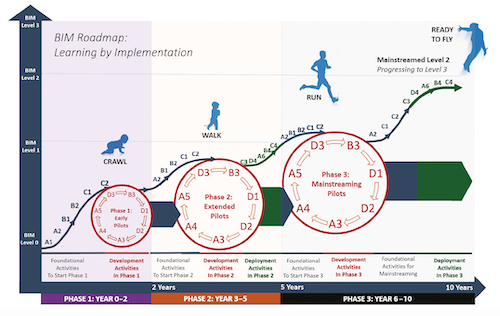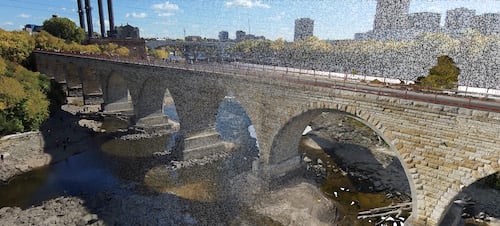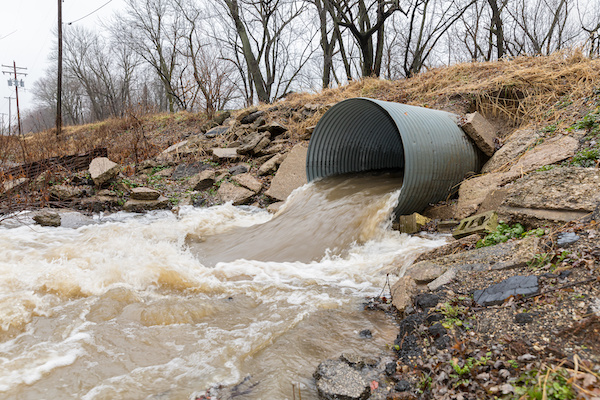With the signing of the $1.2 trillion Infrastructure Investment and Jobs Act last November, scores of public agencies and private architecture, engineering, and construction (AEC) firms are seeing a big wave of new work on the horizon. The IIJA includes $550-billion in new federal investment for infrastructure projects, along with appropriation of previously approved funding.
While distribution of the funds is still unfolding, the effect of the IIJA on AEC professionals appears to be immense, with more than $100-billion targeted for roads and bridges, and additional amounts targeted for road safety, rail, transit, airports, broadband, energy, water, and other projects. Specific grants have also been established for digital delivery of infrastructure projects, and existing grants include “innovation” criteria, opening the door for technology to play a key role in performing the work.
“We definitely see more work coming online as a result of the IIJA,” said Dustin Parkman, vice-president of mobility and transportation at Bentley. With state departments of transportation (DOTs) and their consulting firms already short-staffed, he sees industry professionals leaning heavily on technology to help carry the increased workload, while also expanding their technical capabilities. “We see a massive opportunity for the DOTs and their suppliers to advance their state of the art [technology],” said Parkman.
Grants Pave the Way
Grants targeted for digital delivery could help pave the way for public and private entities to make better use of technology. The IIJA dedicates $100-million over five years ($20 million per fiscal year) to accelerate “adoption of advanced digital construction management systems applied throughout the construction lifecycle,” including through the design and engineering, construction, and operations phases. Goals include:
-
Maximizing interoperability
-
Boosting productivity
-
Managing complexity
-
Reducing project delays and cost overruns
-
Enhancing safety and quality
“The discretionary grant programs are there to incentivize DOTs’ use of technology,” said David McKenney, Bentley’s vice-president of government relations. “Congress realized that from a labor perspective, the state agencies didn't have the labor to keep up with this work.”
The IIJA language calls for more timely and productive information-sharing among stakeholders through reduced reliance on paper, along with systems that leverage the use of digital technologies, such as automated and connected machinery. These and other technologies could help workers “perform tasks faster, safer, more accurately, and with minimal supervision,” according to the bill.
Congress thought to include in other existing grant programs an “innovation” criterion whereby an applicant would include how they plan to use innovative technology to achieve the overall program goals. For instance, if the program is geared towards resiliency, then the applicant would include in its application how they plan on using innovative technology in creating new resilient infrastructure. “This is something that's brand new and really exciting and something we see as potentially having a snowball effect,” said David Lieberman, Bentley’s director of US government relations. “Clearly Congress really is prioritizing this.”
US Playing Catchup
Training and workforce development will be key to increasing digital delivery and efficiency in the U.S. While other countries have widely adopted the use of building information modeling (BIM) and digital techniques to deliver infrastructure work, the U.S. is still primarily relying on paper-based design and construction plans.
“The adoption rate of digital delivery here is only about 20% when you look at the government's own data,” said McKenney. “In the UK, the latest UK BIM report puts that number at 65%. What's the difference? The UK government is strongly incentivizing BIM.” The UK began requiring BIM on government projects in 2016.
A UK BIM Alliance report indicated 65% of respondents are implementing BIM. On a project basis, approximately 60% of the organizations are implementing BIM on a majority of their projects. Image source: UK BIM Alliance. Click to enlarge.
Other countries have also mandated BIM on government projects, or at least set aggressive goals, according to McKenney. “Spain has mandated the use of technology on projects over €2-million since 2018. France is targeting 100% adoption by the end of this year. Germany and Italy are targeting 100% adoption by the end of 2025,” he said. Germany started mandating BIM in 2017 for projects worth over €100-million.
The U.S., meanwhile, has stopped short of mandating BIM, but the IIJA clearly is geared to give BIM a jump-start. “Congress said, ‘We don't want to mandate, but we want to incentivize’, ” noted McKenney.
Parkman also cited China, which has been implementing digital delivery on a growing number of projects. “They've really kind of sprung forward over the last decade to being on the tip of the technology curve,” he said, noting that the U.S. is in a good position to increase adoption of digital delivery. “The good news is, there are a lot of projects that need to be done, and there's no time like the present to get caught up with where the rest of the world is in this regard,” he said.
U.S. government officials see similar opportunities, though with a more gradual adoption of digital delivery than in other countries. A 2021 Federal Highway Administration (FHWA) report issued before the IIJA was signed suggests widespread BIM implementation in the U.S. might take closer to a decade. The report predicts, “BIM processes will be implemented within and across all lifecycle phases to ultimately result in what is referred to as ‘big BIM’ at the end of 10 years.” At that time, the report envisions a scenario where “…state DOTs, in cooperation with their external partners, will have mature BIM processes in place and trained and skilled personnel who use open-data standards, information-exchange specifications, and digital workflows to collaborate with each other.” In 10 years, BIM would achieve a maturity level 2, on a scale of 0 to 3, based on the report.
A US FHWA report suggests a 10-year timeframe for achieve mature BIM implementation. Image source: FHWA. Click to enlarge.
U.S. Secretary of Transportation Secretary Pete Buttigieg sees a similar timeframe needed to fully implement the IIJA. At the Winter 2022 Meeting of the National Governors Association, he said the focus of IIJA is not necessarily to get projects on the street as quickly as possible, but in a timeframe that fits the nation’s economic conditions, supply chain issues, and labor shortages. “This is really about building for the next decade, so when we are programming [IIJA] funds…we should find ways to take into account those conditions,” he said.
UAV performs survey on Stone Arch Bridge in Minneapolis, Minnesota. Image source: Collins Engineers. Click to enlarge.
New Ways of Doing Business
To ramp up digital delivery and tackle the growing workload, US AEC professionals will have to learn and adopt new methodologies. Paper-based plans could largely be replaced by digital 3D models as contractual documents. Digital twins will be used to help stakeholders experience projects before construction in virtual reality. Unmanned aerial vehicles (UAVs), LiDAR, and other tools will be used to perform design surveys and bridge inspections, as demonstrated by Collins Engineers on the Stone Arch Bridge project in Minnesota.
Digital data will likely also play a larger role throughout the lifecycle of bridges, said Parkman. “We're trying to focus on making that information flow all the way through [the life cycle]. Digital data can flow from maintenance and inspection through to design through construction and back over to handover,” he said.
A reality mesh of Stone Arch Bridge in Minneapolis, Minnesota. Using digital imagery to plan repairs saves time and money, plus protects employees as they work on the bridges. Image source: Bentley Systems. Click to enlarge.
Parkman sees bridge repair as a key area of upcoming work, with approximately $40-billion of IIJA funding dedicated for bridges. This includes more than $27-billion targeted for bridge rehabilitation and modernization allocated by formula and more than $12.5-billion for the Bridge Investment Program, a competitive program to replace, rehabilitate, preserve, or protect some of the nation’s most important and economically significant bridges.
The IIJA will also shape roadways of the future, with more intelligent features to monitor traffic conditions and alert drivers of obstacles, incidents, and other issue in real-time. Telecommunications and energy facilities will likely be key considerations in roadway corridors, predicted McKenney. With the growth of electric vehicles, state and local governmental agencies are considering where to put charging stations, and where those charging stations get their energy.
Traffic modeling may use applications such as Bentley’s CUBE product line to more fully leverage information from multiple sources. CUBE is an open modeling software used by planners and engineers to analyze the effects of new projects and policies on a city’s transportation network, land-use, and population. It uses a wide range of data to simulate how changes in infrastructure, operations, technology, and demographics will impact movement and accessibility of a given area. “It's grabbing data from all over and combining that all to create a model,” said McKenney.
With access to more data, technology such as CUBE may also be used to address big-picture questions that might not have been fully considered in the past, noted McKenney. “How can we [build infrastructure] in a way that gives everyone in all types of communities access to the infrastructure? Do we want to reduce emissions? Will that increase congestion? It's always a push-pull. By using all this big data we're able to run through options early in the design phase.”
Bridge repair and rehabilitation is a key part of IIJA funding dedicated for bridges. Image source: Bentley Systems. Click to enlarge.
In addition to the highway and bridge funding, other modes of transportation and infrastructure are also getting big boosts. The IIJA invests more than $66-billion in passenger and freight rail, with another $39-billion targeted for public transit. It allocates $11-billion for transportation safety programs, including a $5-billion program to help states and localities reduce crashes and fatalities in their communities, especially for cyclists and pedestrians. Approximately $25-billion will address airport repair, maintenance, and modernization needs.
Water, energy, and environmental upgrades are also in the works. The IIJA includes $50-billion to help communities make infrastructure more resilient to the impacts of weather events and cyber-attacks, along with $55 billion targeted for providing clean drinking water. A $65-billion investment in broadband is geared to improve access to reliable high-speed internet.
A $70-billion investment in electric power focuses on upgrading the nation’s power infrastructure, including building thousands of miles of new transmission lines to support the expansion of renewable energy.
Six-months after the IIJA became law, funds are starting to flow to actual projects. A White House fact sheet announced that more than $110-billion of IIJA funds had been released for road, bridge, port, airport, water, and internet projects. This includes funding for more than 4,300 specific projects in all 50 states, D.C., and Puerto Rico. One of the major pieces was the first year of funding for the Bridge Formula Program, which provides formula funding to states to replace, rehabilitate, preserve, protect, and construct bridges on public roads. The next round is scheduled to be released in October 2022.
Progress is still slow, however, because of staffing and labor challenges federal agencies are facing. Writing and administering multibillion-dollar grant programs is something that few federal agencies are currently equipped to do. Because of the all-encompassing nature of the IIJA, many agencies have had to hire new program and policy experts to help write the programs. While the aforementioned programs have come out, the majority will be released over the next 12 months.
Technology Providers Adapt
With the onslaught of work, software and technology providers are also adapting business practices to better equip customers for digital delivery. “We've changed our subscription model so that when you subscribe to the software, it allocates a certain amount of expert hours from experts who know those products really well,” said Parkman. Unlike a traditional support model, “this is more of a concierge service that comes with your subscription of your products,” he noted.
Larger customers are also assigned a user success manager, a dedicated manager who makes sure all the technical aspects of the products they're using are fulfilling their intended value. “We have put a lot of emphasis on our user success teams,” said Parkman.
The IIJA will undoubtedly challenge a wide variety of AEC professionals across the U.S. to deliver on a scale not encountered in recent memory. The unprecedented amount of work will come as a welcome relief to firms negatively impacted by the pandemic and other factors. On the flip side, an industry already facing staff shortages will be challenged to find ways to deliver work more efficiently. With proper training and preparation, technology can help fill the gap and help firms accomplish what lies ahead.
By Cadalyst Staff











Share This Post